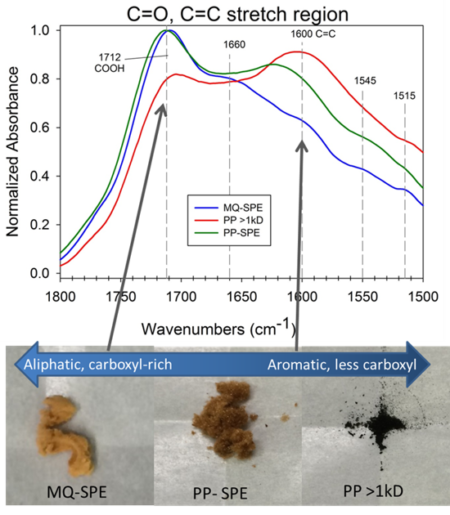
FTIR analysis (top) and pictures (bottom) of three natural organic matter fractions extracted from sediment: water extractable (MQ-SPE), acid-soluble pyrophosphate (PP) extractable (PP-SPE), and acid-insoluble PP extractable (PP >1 kD).
Organic carbon concentrations in sediments more than 1 meter below the land surface are typically 10 to 200 times lower than in surface soils, posing a distinct challenge for characterization. In this SFA study, published in Organic Chemistry, a range of chemical extractions were evaluated for extraction of natural organic matter (NOM) from low-carbon (<0.2%) alluvial sediments and an extraction and purification scheme was developed in order to isolate and characterize different fractions of sediment-associated NOM.
Summary
Surface soils typically contain 5-10% levels of organic carbon (OC), but OC concentrations in sediments more than 1 meter below the land surface are often 10 to 200 times lower, and the usual techniques to measure the chemical characteristics of OC in these sediments are not sufficiently sensitive. In this study, a range of chemical extractions were evaluated for extraction of natural organic matter (NOM) from two low-carbon (<0.2%) alluvial sediments. The OC extraction efficiency followed the order pyrophosphate (PP)>NaOH>HCl, hydroxylamine hydrochloride>dithionite, water. A NOM extraction and purification scheme was developed using sequential extraction with water (MQ) and sodium pyrophosphate at pH 10 (PP), combined with purification by dialysis and solid phase extraction in order to isolate different fractions of sediment-associated NOM. Characterization of these pools of NOM for metal content and by Fourier transform infrared spectroscopy (FITR) showed that the water soluble fraction (MQ-SPE) had a higher fraction of aliphatic and carboxylic groups, while the PP-extractable NOM (PP-SPE and PP >1kD) had higher fractions of C=C groups and higher residual metals. This trend from aliphatic to more aromatic is also supported by the specific UV absorbance at 254 nm (SUVA254) (3.5 vs 5.4 for MQ-SPE and PP-SPE, respectively) and electrospray ionization Fourier transform ion cyclotron resonance spectrometry (ESI-FTICR-MS) data which showed a greater abundance of peaks in the low O/C and high H/C region (0-0.4 O/C, 0.8-2.0 H/C) for the MQ-SPE fraction of NOM. Radiocarbon measurements yielded standard radiocarbon ages of 1020, 3095, and 9360 years BP for PP-SPE, PP >1kD, and residual (non-extractable) OC fractions, indicating an increase in NOM stability correlated with greater metal complexation, apparent molecular weight, and aromaticity.
Citation
P.M. Fox, P.S. Nico, M.M. Tfaily, K. Heckman, and J.A. Davis (2017), “Characterization of natural organic matter in low-carbon sediments: Extraction and analytical approaches.” Organic Geochemistry, 114, 12-22, DOI:10.1016/j.orggeochem.2017.08.009
